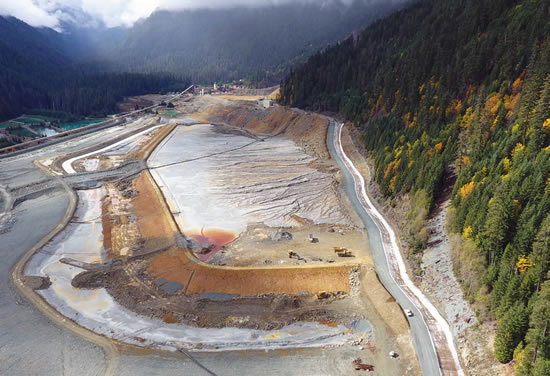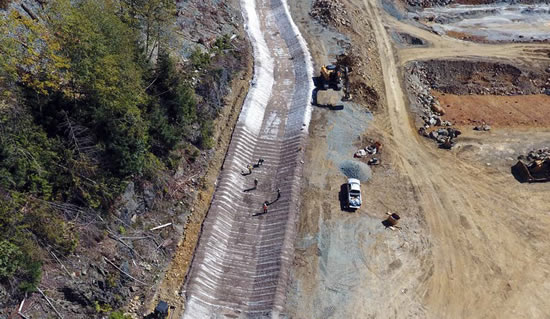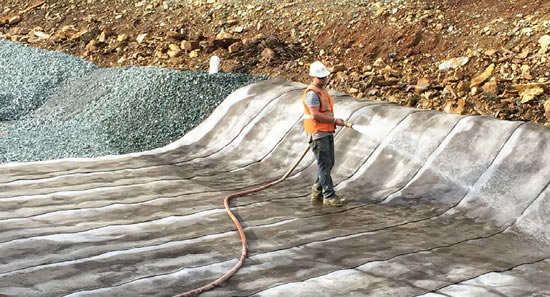In August 2016, over 11,000m2 of Geosynthetic Cementitious Composite Mat (GCCM) was installed as a protective liner for a large diversion channel at an underground zinc and copper mine on Central Vancouver Island, Canada. The project marks one of the largest GCCM installations to date for this geosynthetic barrier system, which is sold as Concrete Cloth in North America and Concrete Canvas in the rest of the world.

The material has grown rapidly in international use in the past few years.
The zinc and copper mine diversion channel, which conveys clean water from the hillside above to a lower creek, was originally lined with shotcrete but the material had begun to degrade over time. Engineers recommended enlarging the diversion channel and realigning it to effectively handle the high-water volume and velocities.
IMPROVING ZINC & COPPER MINE OPERATIONS
Alternative options such as replacement shotcrete were considered, but Concrete Canvas® was specified due to its ability to cope with high water velocities and to accommodate profile variances. The GCCM system is also easy to repair. For the zinc and copper mine site, there was potential future damage from falling trees or large boulders from the hillside above. The GCCM installation could manage these threats quickly with simple repair measures that would restore full barrier functionality quickly.

Also, since the water was diverted away from the channel during installation, the speed of installation was key. The diversion pipes wouldn’t be able to handle the high-water volume expected to begin in early October. The use of CC meant measures could be in place much faster than using conventional concrete or shotcrete.
The system also offered benefits beyond just conventional shotcrete. The fiber reinforcement inherent in the material offered greater durability and design life for the zinc and copper mine needs over other geomembrane-only options that were considered. The composite structure of the GCCM specified featured an integral PVC backing, thus providing the diversion channel the surface durability of concrete and the enhanced barrier performance of a polymeric geomembrane in a single, easy-to-install, rolled product.

GCCM INSTALLATION
The channel was designed to handle water velocities of up to 20m/s with slopes as steep as 16%. In some sections, slopes of 20% had to be incorporated.
Prior to excavating the new diversion channel, the main contractor completely removed and disposed of all trees, brush, and other vegetation growth in the area. Standing water was drained away from the exposed excavated areas to prevent pooling and infiltration.
Prior to installation, a new channel was created, which was significantly wider than the original shotcrete-lined channel. The final channel measured 735m in length and was 5 – 8.5m wide. The average depth was 1.5m with 2:1 side slopes. Due to the anticipated flow velocities, 8mm-thick Concrete Canvas (CC8TM) was specified. The 125m2 CC8TM bulk rolls were delivered to site and positioned strategically along the channel to save time and minimize handling and vehicle movement during installation.
SEE ALSO: Geosynthetic-Concrete Composite Barrier for Brazilian Mine
To account for the variation in profile width, a transverse layup was specified and bulk rolls of CC8TM were deployed from a spreader beam mounted from an excavator to unroll the material across the width of the channel. Adjacent layers of the GCCM were overlapped by 100mm in the direction of water flow and secured using 1.5m earth percussion anchors with 3mm stainless steel cables every meter along the overlaps in conjunction with 8 stainless steel 1” screws at 150mm intervals. The Canvas was pinned into 300mm deep anchor trenches on either side of the channel using the 1.5m earth percussion anchors. The trenches were then backfilled with material to provide a neat termination and to prevent water ingress underneath. When fixing the GCCM to rock in some sections of the channel, Hilti rock anchors and 600mm rock bolts were used.
The material was hydrated using a water truck and due to CC having a very low wash out rate and low alkaline reserve, treatment of the runoff from installation was not required. The barrier system has a working time of approximately two hours from hydration, meaning that work can continue even in very wet conditions. This can reduce program disruption typically caused by the type of bad weather that may delay other barrier system installations.

The zinc and copper mine GCCM installation took 6 weeks to complete with an average crew size of 6 men and daily temperatures up to 34° C (93° F). The client was satisfied with the product and the minimal amount of specialist training or equipment required. In addition to this, the speed of installation meant the project was completed before the heavier precipitation arrived at the mine.
Learn more at www.concretecanvas.com.











